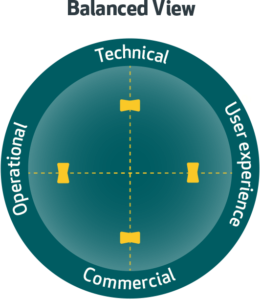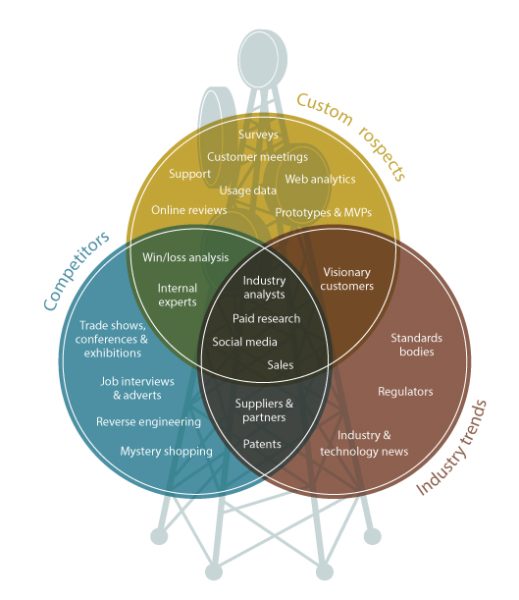
Are you about to start a new job?
Maybe you’re starting the process of looking for one? Or perhaps you’ve just started somewhere and are wondering what to focus on first?
Whether you’re leaving a company for new opportunities or changing your role within your current company, it can be a daunting prospect when you start a new product management job.
It can feel like standing at the top of a ski run. It’s exhilarating but also a little scary. You’re hoping not to fall flat on your face.

It usually takes around three months for someone to be entirely up to speed in a new role, so those first 90 days are a crucial time to show you can do the job and earn the trust of your colleagues.
If this feels familiar, our New Job Checklist is here to help!
It’s an easy-to-follow infographic broken down into key milestones along your 90-day journey, so you can be reassured you have thought of everything.
Download it here, and read on to learn more about managing and achieving success in those critical first three months.
What’s the purpose of your product management job?
Let’s start with the fundamentals – our experience is that every product management job is slightly different. The role can vary significantly based on:
- The type of product you have – software, hardware, people-based services
- The size of your company
- How mature and established product management is as a function
- How the different product-related activities are split between different roles across the business
- What stage of the lifecycle your product is currently at
But there are three key fundamentals of product management that you need to understand from the beginning – regardless of industry, company size, or type of product. We see this as the purpose of your job.
1. Provide a balanced view
 Firstly, you need to have a balanced view of your product across all the technical, commercial, user experience, and operational aspects to make and recommend unbiased suggestions. When you start a new job, you will likely find that many people across other departments will have strong views about what should happen with your product. To begin with, you’ll need to listen to them and develop your knowledge while learning to understand what they expect of you.
Firstly, you need to have a balanced view of your product across all the technical, commercial, user experience, and operational aspects to make and recommend unbiased suggestions. When you start a new job, you will likely find that many people across other departments will have strong views about what should happen with your product. To begin with, you’ll need to listen to them and develop your knowledge while learning to understand what they expect of you.
To start with, you’re likely to be pulled into tactical issues that need fixing, and you’ll need to show willingness and get involved. You’ll likely not yet know enough to judge what’s important or not, but the danger is that your job can then become purely about fixing issues. According to our Survey on the PM profession, the average product person spends a considerable portion of their time firefighting – so it’s something to bear in mind.
The aim is to get to a point in your new product manager role where you have a helicopter view of all the different aspects of your products. Someone has to understand the pros and cons of all the options for your product and be able to make or recommend the best decision for the business – and we think that as the product manager, that should be you.
You have to learn to balance short-term tactical activities with longer-term strategic activities. It’s a bit like being both the builder and the architect – you have to be able to do both.
2. Become the voice of the market for your product
 Another core part of your role involves being an expert on what customers in your market want. It would be best if you had this understanding and insights to create your roadmap, gather requirements, and develop your propositions and product strategy. And, it’s about more than just understanding existing customers. It includes prospects, competitors, and market trends.
Another core part of your role involves being an expert on what customers in your market want. It would be best if you had this understanding and insights to create your roadmap, gather requirements, and develop your propositions and product strategy. And, it’s about more than just understanding existing customers. It includes prospects, competitors, and market trends.
This will give you power when persuading colleagues to support you because you have the data and insights to support your views.
To do this, you must set up a network of ‘listening posts’ and do discovery activities directly with customers.
These ‘listening posts’ can include speaking to sales and support teams, talking to suppliers, going to conferences, searching the web, or even commissioning paid research.
It’s best practice to set these up as part of your ongoing job, as some are easy to do, and some can take time and money.
We think a key part of any product management job should be to build up and nurture this network of listening posts and have them in place to drip-feed insights into you, supporting you in becoming the voice of the market for your product within your company. See our infographic here.
3. Care about the success of your product
When it comes to product managing your product, you need to take on and feel ownership of your product and customers. Your job as a Product Manager is to uncover your customer’s problems and develop a product that solves them profitably for your company. You should be a leader within your business for your product. We liken it to being a ‘mini-CEO,’ running your product as a little business within your company to support the overall business strategy.
What you should do in the first 90 days
With these fundamentals in place, you will already be on your way to succeeding within your new product management role. The first 90 days are crucial in demonstrating enough of your abilities and earning the trust of your colleagues while getting to grips with your new job. Here are our top tips for those first 90 days:
Before you start
- Check out the LinkedIn details of your boss and company – this helps you put a face to the name, as well as get a feel for your new company’s mission statement and proposition
- Review competitor websites – how are others managing similar products to yours?
- Review the company’s external website and Wikipedia entry – your first impressions can be useful
During your first day
- Listen (rather than speak) – learn from the people around you
- Meet as many people as possible (and smile!) and ask, “What are you expecting of me?”
- Have handshakes with important stakeholders and plan subsequent meetings
- Get your basic tools set up: computer, phone, email, and internet
- Plan meetings for the next few weeks with key stakeholders and get hold of the Organizational Chart
During your first week
- Identify important internal meetings
- Get on the right internal distribution lists, e.g., weekly development reports, sales reports, press releases, customer support statistics, etc.
- Find external informational sources from colleagues, e.g., market intelligence reports, analysis, friendly customers
- Identify the Power Brokers in the company (the key stakeholders you will need to influence)
- Schedule regular reviews with your boss to check you are on track
- Ask for a product demo from Sales and Development. Find out why customers buy and what problems your product solves
- Understand the customer buying process – how long does it take, and who makes the decisions?
- Read the product collateral – as much of it as you can find
- Understand the ‘stated’ company strategy and objectives
- Sniff out ‘Bombs’ that are about to explode and determine the length of the fuse (issues you will need to deal with)
During your first month
- Organize an off-site lunch with PMs and close teammates
- Make no promises & frequently repeat, “I’m here to listen and understand.”
- Probe – remember, in the first month, you can still ask naïve questions and get away with it
- Have a demonstrable success
- Have your weekly structure defined (meetings, reports, reviews, etc.)
- Understand how things work in your company and the approval process for getting stuff done
- Use the Product Focus Product Activities Framework to understand who does which product activity
- Understand the objectives of other business functions, so you know how to work with them
- Visit a customer (or several preferably) with Sales or Account Management if necessary
- Get involved in a Sales Pipeline Funnel Review
- Become the expert on the business requirements for the product. Who is using the product, how, and why?
- Understand the business/requirements of the top 10% of your customers
- Understand the revenue breakdown by product(s)
- Review Customer Support tickets with the Support Manager
- If working with Agile, be the Product Owner (or have a proxy) and be a participant in a Sprint cycle (if your company uses Scrum)
- Review the “Product Backlog” and roadmap if they exist
- Get or create a product dashboard including sales numbers and revenue
- Identify strengths and weaknesses of the product – this may be a good time to do a SWOT analysis
By the end of the first quarter (90 days)
- Work out how to prioritize your time
- Work out how to improve the key processes if necessary
- Gain approval for a major product development – or at least understand how that works
- Produce a Product Business Plan
- Set up your own KPIs (Key Performance Indicators)
- Join sales on a prospecting call. Listen in on some support calls
- Understand customer and industry vocabulary and jargon
- Be the Market Expert – know what customers want and what problems they have
- Be the Customer Advocate in the business
- Calculate the financial performance of your product
- Be the Product Expert. Have a vision for the product
- Have the product collateral/messaging/web content updated and be able to demo the product
- Map the existing Roadmap and propose a new Roadmap
- If you have multiple products, then show them on a BCG or McKinsey matrix to get insights across the portfolio
- Evaluate your training needs
Summary
Starting a new job, whatever the industry, can be tough. Remember, you need to understand what’s happening and make sure people know you’ve delivered, particularly in bigger businesses. And try not to forget the fundamentals of the product management role:
- To provide a balanced view
- To become the voice of the market for your product
- To lead and drive the success of your product
So, whether you’re leaving a company for new pastures or getting promoted within your current company, download our free New Job Checklist to support your success.
NB: The checklist was created at a meeting of the Cambridge Product Management Network in a session led by Arthur Meadows in the UK. Initially developed for someone moving into a new product management role in a small B2B software company – but applicable to any new product management role.


Join the conversation - 2 replies
This is such a helpful guide for anyone stepping into a new product management role. I especially appreciate the tips on understanding the product and market, as well as the practical steps for the first month. It’s reassuring to have a roadmap for those crucial early days. I’ll definitely be downloading the checklist!
Christine Dalayap
https://jpfranklinroofing.co.nz
Thank you for the great feedback! We’re glad the blog is helpful to you.